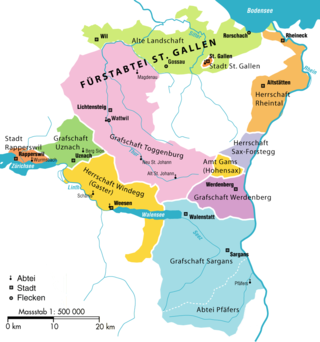
The canton of Schwyz is a canton in central Switzerland between the Alps in the south, Lake Lucerne to the west and Lake Zürich in the north, centred on and named after the town of Schwyz.

Unterwalden, translated from the Latin inter silvas, is the old name of a forest-canton of the Old Swiss Confederacy in central Switzerland, south of Lake Lucerne, consisting of two valleys or Talschaften, now two separate Swiss cantons, Obwalden and Nidwalden.

The 26 cantons of Switzerland are the member states of the Swiss Confederation. The nucleus of the Swiss Confederacy in the form of the first three confederate allies used to be referred to as the Waldstätte. Two important periods in the development of the Old Swiss Confederacy are summarized by the terms Acht Orte and Dreizehn Orte.

The Battle of Morgarten took place on 15 November 1315, when troops of Schwyz, supported by their allies of Uri and Unterwalden, ambushed an Austrian army under the command of Leopold I, Duke of Austria on the shores of Lake Ägeri, in the territory of Schwyz.

Nidwalden or Nidwald is one of the 26 cantons forming the Swiss Confederation. It is composed of eleven municipalities and the seat of the government and parliament is in Stans. It is traditionally considered a "half-canton", the other half being Obwalden.

Each of the 26 modern cantons of Switzerland has an official flag and a coat of arms. The history of development of these designs spans the 13th to the 20th centuries.

The Old Swiss Confederacy began as a late medieval alliance between the communities of the valleys in the Central Alps, at the time part of the Holy Roman Empire, to facilitate the management of common interests such as free trade and to ensure the peace along the important trade routes through the mountains. The Hohenstaufen emperors had granted these valleys reichsfrei status in the early 13th century. As reichsfrei regions, the cantons of Uri, Schwyz, and Unterwalden were under the direct authority of the emperor without any intermediate liege lords and thus were largely autonomous.

Eidgenossenschaft is a German word specific to the political history of Switzerland. It means "oath commonwealth" or "oath alliance", in reference to the "eternal pacts" formed between the Eight Cantons of the Old Swiss Confederacy of the late medieval period. In Swiss historiography, this relates most notably to the Rütlischwur between the three founding cantons Uri, Schwyz and Unterwalden, which traditionally dates to 1307. In modern usage, Eidgenossenschaft is the German term used as an equivalent to "Confederation" in the official name of Switzerland, Schweizerische Eidgenossenschaft. Its corresponding adjective, eidgenössisch—officially translated as "Swiss federal"—is used in the name of organisations such as the Eidgenössische Technische Hochschule, or Swiss Federal Institute of Technology. The term Eidgenosse refers to individual members of the Eidgenossenschaft. It is attested as early as 1315 in the Pact of Brunnen, referring to the cantons of Uri, Schwyz and Unterwalden. The abstract noun Eidgenossenschaft is attested in the 15th century. In modern usage, Eidgenosse is sometimes used in archaic or ironic usage for "Swiss citizen", especially for those citizens of purely Swiss origin and not from immigration.

The early modern history of the Old Swiss Confederacy and its constituent Thirteen Cantons encompasses the time of the Thirty Years' War (1618–1648) until the French invasion of 1798.

The Second War of Kappel was an armed conflict in 1531 between the Catholic and the Protestant cantons of the Old Swiss Confederacy during the Reformation in Switzerland.

Waldstätte is a term which has been used since the early thirteenth century to refer to the Stätte, or later Ort or Stand of the early confederate allies of Uri, Schwyz and Unterwalden in today's Central Switzerland.

The Rütli Oath is the legendary oath taken at the foundation of the Old Swiss Confederacy by the representatives of the three founding cantons, Uri, Schwyz and Unterwalden. It is named after the site of the oath taking, the Rütli, a meadow above Lake Uri near Seelisberg. Recorded in Swiss historiography from the 15th century, the oath is notably featured in the 19th century play William Tell by Friedrich Schiller.

Swiss National Day is the national holiday of Switzerland, set on 1 August. Although the founding of the Swiss Confederacy was first celebrated on this date in 1891 and annually since 1899, it has only been an official holiday since 1994.

The Old Swiss Confederacy, also known as Switzerland or the Swiss Confederacy, was a loose confederation of independent small states, initially within the Holy Roman Empire. It is the precursor of the modern state of Switzerland.

The County of Sargans was a state of the Holy Roman Empire. From 1458 until the French Revolutionary War in 1798, Sargans became a condominium of the Old Swiss Confederacy, administered jointly by the cantons of Uri, Schwyz, Unterwalden, Lucerne, Zürich, Glarus and Zug.
The Pact of Brunnen is a historical treaty between the cantons of Uri, Schwyz, Unterwalden, concluded in Brunnen on 9 December 1315.

When the Imperial Circles — comprising a regional grouping of territories of the Holy Roman Empire — were created as part of the Imperial Reform at the 1500 Diet of Augsburg, many Imperial territories remained unencircled.

Uri is a Swiss Talschaft and canton in the upper Reuss valley.

The Second Battle of Ulrichen was fought in 1419 between the Old Swiss Confederacy led by Bern and rebels from Valais near Ulrichen in the district of Goms in the canton of Valais in Switzerland. Negotiations after the battle led to the end of the Raron affair and self-determination for Valais.

Swiss Associates, also known as Associated Places,Zugewandte Orte, or Pays Alliés, were associate states of the Old Swiss Confederacy, with some form of alliance agreement with either the entire Confederation or individual cantons.




















